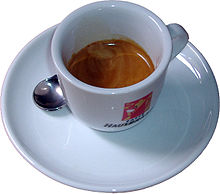Espresso
![]()
This article is about the preparation of coffee; for other meanings of this term, see Espresso (disambiguation).
Espresso [![]()
![]() ˌɛsˈpʀɛso] is a coffee preparation method originating in Milan, in which hot water is pressed at high pressure through very finely ground coffee grounds made from roasted coffee beans.
ˌɛsˈpʀɛso] is a coffee preparation method originating in Milan, in which hot water is pressed at high pressure through very finely ground coffee grounds made from roasted coffee beans.
The process produces a concentrated coffee on which there is a dense, hazelnut-brown layer of foam - the crema - which contributes to its aroma. Due to the strong roasting, the ground coffee for espresso contains less caffeine than an equal amount of ground coffee for filter coffee. Accordingly, at typical serving sizes, the amount of caffeine per cup of espresso is also less than per cup of filter coffee. Only the concentration of caffeine is higher because less water is used in the preparation (typically 25 ml of water for espresso, but 125 ml for filter coffee). Espresso is served in small, thick-walled, pre-warmed cups of about 40 ml capacity. It is drunk sweetened or unsweetened and often served with a glass of water.
Espresso is the most common way of preparing coffee in Southern Europe, especially in Italy, Spain, Portugal and France. In these countries, you get an espresso when you order coffee: Italian caffè, French café, Spanish café, Portuguese café, Greek καφές, Bulgarian кафе, Croatian kava.
In Switzerland, espresso is mostly prepared, in German-speaking Switzerland most often as espresso lungo (German Café crème: Verlängerter, coffee), in French-speaking Switzerland as normal espresso.

Espresso
Origin and etymology
Espresso has its roots in Italy, where this type of coffee preparation emerged in Milan around 1900. There, before the introduction of other methods, it was prepared exclusively with steam and served in bars only at the counter.
The term espresso goes back to so-called "coffee locomotives" manufactured between 1840 and 1870. Their name alludes to the analogy of preparing coffee with steam and a steam locomotive. Luigi Bezzera of Milan was able to capitalize on the popularity of the association of coffee with steam-powered express trains when he patented the first machine for caffè espresso in 1901. The word espresso is thus a borrowing from English, where the term express for fast train has been documented since the mid-19th century.
In various linguistic areas, espresso is spelled with an "x", for example in Spain (café expreso), Portugal (café expresso) and Romania (cafea expres).
The espresso bean
→ Main article: Coffee bean
Espresso is usually based on darker roasted blends - often with a slightly higher proportion of Robusta. Due to the dark roasting, the bean largely loses its taste-perceptible acids - much more so than with the lighter filter coffee roasting. This is intentional, as the acid dissipates disproportionately quickly due to the high pressure method of preparation. An espresso drink based on light coffee grounds has noticeable acidity. However, this apparent contradiction to traditional espresso can also be deliberately aimed at: light espresso roasts with fruity notes have been in vogue for some time.
With increasing degree of roasting there is also a shift in the bitterness profile. While "soft" bitter elements initially form in the course of roasting (light to medium degrees of roasting), these are largely reduced again in darker roast samples and increasingly formed "harsh" bitter elements dominate.
Robusta beans are considered less aromatic than Arabica, but bring a fuller body to the espresso drink and thus form the typical heaviness of espresso. In addition, it is significantly easier to create a good crema with a robusta blend than with an espresso made from a pure arabica blend.
Search within the encyclopedia